 A Survey 1952 -1992 | KUKJE GALLERY
A Survey 1952 -1992 | KUKJE GALLERY
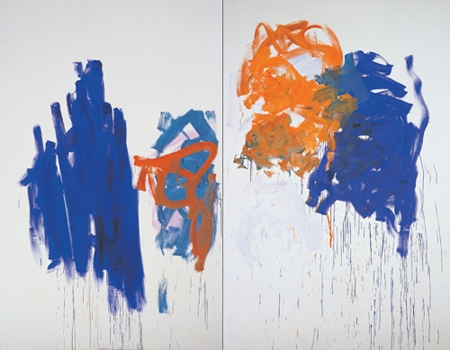
Mar 3, 2006 - Apr 4, 2006
K1
Seoul
INTRODUCTION
30 January 2006
Joan Mitchell/Kukje Exhibition
Richard D. Marshall
Joan Mitchell was born in Chicago in 1925, and as a young child was familiar with and impressed by the outstanding collection of the Art Institute of Chicago. Even at a young age, she responded to paintings by Cezanne, Matisse, Renior, and Van Gogh, and they remained strong influences on her mature work. As a child and teenager, Mitchell was actively involved with sports and was an avid swimmer and competitive ice skater, which is apparent in the strong, physical qualities that characterize her athletic handling of a brush and paint. In 1944, she left Smith College, in Massachusetts, to attend the school of the Art Institute of Chicago and went on to receive both her bachelor’s and master’s degree in Fine Arts. She moved to New York in 1950 determined to pursue her aesthetic vision.
The first year that Mitchell moved to New York, she viewed a new Willem de Kooning painting in the "1950 Annual Exhibition of Painting" at the Whitney Museum. She was so impressed and stimulated by his work that she was determined to meet the artist, and accomplished this with the help of Franz Kline during the summer of 1950. Mitchell was encouraged by the vibrant aesthetic atmosphere that was forging a new abstract ideology and attracted to the boisterous downtown art scene in New York. She frequented the popular artists’ hangout, the Cedar Street Tavern, and participated in the nocturnal gatherings which were presided over by such senior figures as de Kooning, Kline, Jackson Pollock, and Philip Guston. They were impressed with Mitchell’s determination and talent, and invited her to join the "Artists’ Club," a group that assembled for intellectual and social occasions of shared interests in art, alcohol, and mutual support.
In the male-dominated climate of the period, Mitchell was one of the few women artists, including Elaine de Kooning, Helen Frankenthaler, and Lee Krasner, to be included in "The Club." Mitchell’s acceptance into this group facilitated her inclusion in the historic "Ninth Street Exhibition of Painting and Sculpture" that was coordinated by Leo Castelli and held in May 1951. The exhibition included works by seventy artists, and Mitchell’s painting was widely praised by de Kooning, Kline, and Hans Hofmann, who were also in the exhibition. Mitchell’s inclusion in this important show, which proclaimed the importance of the new abstract painting, coupled with the endorsement of established and respected artists, greatly enhanced her reputation as an artist of significance and launched her on a productive and meritorious forty-year career.
Throughout her evolution as an abstract painter, Mitchell consistently sought to converge her interests in nature, emotion, and painting. Her subjects are landscape, color, and light, and their interaction on a painterly field, combined with an energetic physical gesture infused with a romantic sensibility. Mitchell sought to convey allusions to nature through the use of painterly line and movement that would recall, but not describe, memories, sensations, and feelings of the natural world: "I paint from remembered landscapes that I carry with me--and remembered feelings of them, which of course become transformed.... I would rather leave nature to itself. I do not want to improve it...I could certainly never mirror it. I would like more to paint what it leaves me with." Mitchell’s paint application was considered, strong, and calligraphic, and she would deliberate before attacking the canvas and her strokes would retain their linear gesture, yet her paintings continually fluctuate between a total abstraction of line and color and the visual suggestion of something familiar or remembered.
Mitchell’s absorption of herself into her paintings is a constant and determining motivation. She uses painting to submerge cognitive thinking and to transform her memories of times and places into a supernatural expression. Even her earliest works, such as Untitled, 1952-53 and Number 12, 1953-54 recall periods of her life in Chicago and her memories of Lake Michigan. Her expressive manipulation of the liquidity of the paint hints at the shimmering reflection of light on the water or the reflection of the lights of the city on the lake. As she recalled: "My paintings repeat a feeling about Lake Michigan, or water, or fields...more like a poem, and that’s what I want to paint...the Great Lakes, with the wind and the weather...the lake to me was always in my nightmares...the crashing of the waves." Her concern with nature and atmospheric phenomenon encompass her entire life, extending from her childhood memories of Lake Michigan, through her New York City apartments on the East River and in Brooklyn, her frequent sailing trips on the Mediterranean, to her life in the French countryside of Vetheuil.
The composition of Joan Mitchell’s paintings vary with the period, subject, and mood of the artist, and range from smooth, overall coverage and balance, to awkward, lopsided markings and disproportionate paint application. By the late 1950s, her canvases display a more energetic and overall composition. Untitled, 1956 and Untitled, 1957 contain wide swaths of greens and drips that allow the act of painting and the physical qualities of paint to become apparent. Works from 1960s shift from the intensely colored, calligraphic brushstrokes of her earlier (and later) paintings, and display heavy, weighted masses of dark paint, congealed in asymmetrical positions on the canvas, as in La Chatiere, 1960, and Untitled, 1964. A related composition is seen in Untitled, 1961, which is a wide horizontal format that contains tighter and lighter colors and strokes at the top of the canvas, and denser and wider gestures toward the lower section, all of which are slashed through with marks of blue.
In addition to water and landscape, the subject of trees and flowers also permeate Mitchell’s cognizance. One tree in particular--a massive one that dominates her terrace in Vetheuil--is a recurring image and a strong-felt memory that appears in the two-panel paintings, Untitled, 1977. This work is inundated with variations of blue and green brushstrokes arranged in a dense vertical articulation that suggest thick foliage of a tree with small acknowledgments of the orange sun in the upper right and open air and blue sky at the lower left. Similarly, Cypress, 1980, is a painting of trees and it manifests Mitchell’s great admiration for the paintings of Vincent Van Gogh, and is related in subject matter and palette to his landscapes. She has captured the chaotic movements in the blue sky, dominated by intense streaks of sunlight in vivid yellow and orange. At the center of the painting are two slashes of green-black, and a few others at the lower left, that represent the cypress trees that she admired during a visit to Provence.
Captured movement is a constant characteristic of Mitchell’s paintings, and her painted memories of and responses to landscape carry with them all of nature’s activity, both calm and violent. The expansive, four-panel painting, Edrita Fried, 1980, is an explosion of painterly activity in blues and yellows. It is one of the very few Mitchell works that suggest a sequential reading from left to right, and it builds to a crescendo of bursting yellow-gold brushstrokes that appear to have overcome the hovering weight of dark blues at the left. This painting was titled in memory of Mitchell’s long-time friend and psychiatrist, and may convey the artist’s recollections of the calm, agitation, introspection, and revelation that accompany close personal relationships. A related four-panel work, Minnesota, 1980, also alludes to landscape with its panoramic horizontality and suggestion of thick trees on the outer two panels that frame a relatively open center of broad yellow sky with low vegetation at the bottom. Although Mitchell’s title offers a location that may hold fond memories, her painterly rendition of nature is lushly consistent in its elusiveness and displays her total commitment to the act of painting: "When I am working, I am only aware of the canvas and what it tells me to do. I am certainly not aware of myself. Painting is a way of forgetting oneself...I am not there any more. It is a state of non-self-consciousness. It does not happen often. I am hoping it might happen again. It is lovely."
The paintings completed in the last decade of Joan Mitchell’s life display an extraordinary synthesis of her earlier work and a much more radical, free, and open configuration of abstract gesture. During the early 1980s, illness and death had overcome a number of people close to Mitchell, including her sister, her New York art dealer, friends, and even her favorite German Shepherd dog. To compound this difficult period in her life, Mitchell was diagnosed with cancer and also underwent a serious hip-replacement surgery that left her mobility impaired. Mitchell became painfully aware of her own mortality, and responded with a sustained burst of artistic activity that surpassed in power and ambition even her own already lauded and substantial body of work. Mitchell feared the inevitable relapse of her cancer, and time became a crucial factor in achieving her ultimate aesthetic expression.
The late paintings, as exemplified by Lille IV, 1986 and Merci, 1992, express a determined paring down of visual distraction and a bold assuredness of technique. Their surfaces are characterized by larger expanses of white and a faster and confident thrust of saturated color. Mitchell allowed the line and the color to become the subject, eliminating both over-worked brushing and mixing colors on the canvas. She also worked with a wider brush that was heavily loaded with paint, and she left her expressive marks where they were first put down on the surface of the painting. The composition of these late paintings seems to defy gravity and thrust upwards, accentuating their gestural movement and releasing the artist from herself and her subjects. Mitchell describes her attention to formal concerns in this manner: "I do think about how it’s working, and by that I mean making the background equal to the subject in weight. On the other hand, I’m not at all interested in composition. I don’t mind having all the weight in the middle or on one side, or all the edges finished or unfinished."
Lille IV is one from a series of paintings that Mitchell completed after a memorable stay in the French town of Lille, and each work displays a different palette and temperament. Lille IV is dark and moody, suggesting inclement weather or a depressed mood. It is composed of two panels, each displaying broad sweeps of black, blue, and white. Mitchell’s use of two panels allowed her to compose paintings like a poem, divided into stanzas with breaks and shifts that sometimes repeat and recycle. The panels also function to separate activities and to define spans of time so that each of the panels become a separate theatrical act in the same play. Lille IV, like all of Mitchell’s paintings, is an expressionistic performance composed of paint, color, gesture, and intellect, and she has masterfully combined these elements to create a powerful visual statement that resonates with emotion and beauty.
Riviere, 1990 is one of the most consummate paintings of Mitchell’s late work. It is grand and confident in its physical size, forceful execution, and complicated composition. The subject of the painting, like the large majority of her works, is an impression or memory of a familiar landscape--both a physical and a mental landscape. Recalling the immediate surrounding of her studio in Vetheuil, Mitchell has painted an abstract landscape of the River Seine, including trees, flowers, sun, sky, and water in exuberant gestures and lush colors. The painting is dominated by her favorite blue, green, red, and yellow, and expresses Mitchell’s quest to simultaneously acknowledge and dismiss time by pushing her abstraction to a less conscious level and by demanding a quicker and more deliberate gesture from her hand.
The painting is a field of activity and of color, suggesting a landscape caught in a sudden gust of wind and rain. The gesture is rapid and angry, and reveals Mitchell’s imposition of her own feelings onto her abstract representation of a landscape. External forces have disrupted her normal tranquil and colorful nature that result in twisted and contorted gestures that quickly change direction in vertical and horizontal strokes and differing densities of paint. Like all of Mitchell’s work, Riviere fluctuates between a total abstraction of line and color, and the visual suggestion of something familiar or remembered, such as the beloved Seine, seen here in horizontal brushstrokes of deep blue across the center of the canvas.
Mitchell utilized the diptych format in a number of paintings throughout her career, including Riviere. In addition to her concern with line, gesture, and color in achieving an emotive abstraction, Mitchell paid careful attention to the formal attributes of paintings, such as scale, proportion, surface composition, and physical structure. In a practical manner, the use of two panels permitted the artist to achieve a larger horizontal dimension for her works. The size of Mitchell’s studio did not allow for both canvases to be assembled on the wall at one time, so that the artist worked on them individually and concurrently, occasionally joining the left and right panel in order to deliberate on their progress and interaction. As a result, there are no instances in Riviere where individual brushstrokes stretch across adjoining canvases. In addition, considering Mitchell’s progressive illness and weakness, debilitating pain, and restrictive hip movement, it is impressive that she could accomplish a painting of such overpowering strength and physical magnitude while climbing up and down a ladder holding a large brush heavily laden with paint.
Merci, 1992, is one of Mitchell’s last paintings and is decidedly more spare and restrained than previous works. It consists of only four painterly episodes, using four colors, on an expanse of unpainted canvas. As is customary, Mitchell’s painted references are about nature, and the long, blue vertical brushstrokes at the left are reminiscent of tree forms that she has used previously. The other three forms, in dark blue, orange, and turquoise, are tighter and more circular, and are redolent of images created by Mitchell to symbolize sunflowers. This particular flower fascinated the artist, and she frequently used these circular forms to suggest the shape of the flower, not only to evoke the vibrant, life-assuring yellows of sunflowers, but the darker, more moody colors of dying and decaying flowers. She has said: "Sunflowers are something I feel very intensely. They look so wonderful when young and they are so very moving when they are dying. I don’t like fields of sunflowers. I like them alone or, of course, painted by Van Gogh."
Just as all of Mitchell’s paintings capture a moment of her life, or remembrances of her life, in the dying sunflowers she has again painted her feelings. Now in failing health, she has become the dying sunflower, realizing that she will ultimately loose herself finally into her art, and only the paintings will remain to convey her feelings and memories. The title of the painting, Merci, is a deep-felt expression of gratitude for her life as an artist.
During the 1940s, the Abstract Expressionists established the foundations for an entirely new painterly expression that would strengthen and grow into one of the defining movements of the twentieth century. By 1950, this new style of gestural abstract painting quickly gained a fervent advocate in Joan Mitchell, who helped it expand and flourish during the next decades. Fortunately, Mitchell, as well as de Kooning, Picasso, and Matisse, lived long and productive lives that allowed them to continue to advance and define the nature of art, and fully develop their own personal visual language of gesture and subject. Mitchell felt a deep commitment to and love of the physical act of painting and aspired to a deeper understanding of the making of art. With her personal vocabulary of brushwork and colors, she fused abstract and representational elements to create paintings that expressed sincere and emotive allusions to the world and to the self. During the 1980s, Mitchell became subject to the repercussions of aging and her paintings express a more intent look toward the future and absorption of the past. Joan Mitchell's paintings continually reveal a sense of excitement and clarity, and a daring exploration of color, form, and reference. Since the beginning of her career, Mitchell advanced and enhanced the realization of her individual aesthetic vision, and consequently brought to completion a career characterized by invention, risk, continuity, and brilliance.
Joan Mitchell/Kukje Exhibition
Richard D. Marshall
Joan Mitchell was born in Chicago in 1925, and as a young child was familiar with and impressed by the outstanding collection of the Art Institute of Chicago. Even at a young age, she responded to paintings by Cezanne, Matisse, Renior, and Van Gogh, and they remained strong influences on her mature work. As a child and teenager, Mitchell was actively involved with sports and was an avid swimmer and competitive ice skater, which is apparent in the strong, physical qualities that characterize her athletic handling of a brush and paint. In 1944, she left Smith College, in Massachusetts, to attend the school of the Art Institute of Chicago and went on to receive both her bachelor’s and master’s degree in Fine Arts. She moved to New York in 1950 determined to pursue her aesthetic vision.
The first year that Mitchell moved to New York, she viewed a new Willem de Kooning painting in the "1950 Annual Exhibition of Painting" at the Whitney Museum. She was so impressed and stimulated by his work that she was determined to meet the artist, and accomplished this with the help of Franz Kline during the summer of 1950. Mitchell was encouraged by the vibrant aesthetic atmosphere that was forging a new abstract ideology and attracted to the boisterous downtown art scene in New York. She frequented the popular artists’ hangout, the Cedar Street Tavern, and participated in the nocturnal gatherings which were presided over by such senior figures as de Kooning, Kline, Jackson Pollock, and Philip Guston. They were impressed with Mitchell’s determination and talent, and invited her to join the "Artists’ Club," a group that assembled for intellectual and social occasions of shared interests in art, alcohol, and mutual support.
In the male-dominated climate of the period, Mitchell was one of the few women artists, including Elaine de Kooning, Helen Frankenthaler, and Lee Krasner, to be included in "The Club." Mitchell’s acceptance into this group facilitated her inclusion in the historic "Ninth Street Exhibition of Painting and Sculpture" that was coordinated by Leo Castelli and held in May 1951. The exhibition included works by seventy artists, and Mitchell’s painting was widely praised by de Kooning, Kline, and Hans Hofmann, who were also in the exhibition. Mitchell’s inclusion in this important show, which proclaimed the importance of the new abstract painting, coupled with the endorsement of established and respected artists, greatly enhanced her reputation as an artist of significance and launched her on a productive and meritorious forty-year career.
Throughout her evolution as an abstract painter, Mitchell consistently sought to converge her interests in nature, emotion, and painting. Her subjects are landscape, color, and light, and their interaction on a painterly field, combined with an energetic physical gesture infused with a romantic sensibility. Mitchell sought to convey allusions to nature through the use of painterly line and movement that would recall, but not describe, memories, sensations, and feelings of the natural world: "I paint from remembered landscapes that I carry with me--and remembered feelings of them, which of course become transformed.... I would rather leave nature to itself. I do not want to improve it...I could certainly never mirror it. I would like more to paint what it leaves me with." Mitchell’s paint application was considered, strong, and calligraphic, and she would deliberate before attacking the canvas and her strokes would retain their linear gesture, yet her paintings continually fluctuate between a total abstraction of line and color and the visual suggestion of something familiar or remembered.
Mitchell’s absorption of herself into her paintings is a constant and determining motivation. She uses painting to submerge cognitive thinking and to transform her memories of times and places into a supernatural expression. Even her earliest works, such as Untitled, 1952-53 and Number 12, 1953-54 recall periods of her life in Chicago and her memories of Lake Michigan. Her expressive manipulation of the liquidity of the paint hints at the shimmering reflection of light on the water or the reflection of the lights of the city on the lake. As she recalled: "My paintings repeat a feeling about Lake Michigan, or water, or fields...more like a poem, and that’s what I want to paint...the Great Lakes, with the wind and the weather...the lake to me was always in my nightmares...the crashing of the waves." Her concern with nature and atmospheric phenomenon encompass her entire life, extending from her childhood memories of Lake Michigan, through her New York City apartments on the East River and in Brooklyn, her frequent sailing trips on the Mediterranean, to her life in the French countryside of Vetheuil.
The composition of Joan Mitchell’s paintings vary with the period, subject, and mood of the artist, and range from smooth, overall coverage and balance, to awkward, lopsided markings and disproportionate paint application. By the late 1950s, her canvases display a more energetic and overall composition. Untitled, 1956 and Untitled, 1957 contain wide swaths of greens and drips that allow the act of painting and the physical qualities of paint to become apparent. Works from 1960s shift from the intensely colored, calligraphic brushstrokes of her earlier (and later) paintings, and display heavy, weighted masses of dark paint, congealed in asymmetrical positions on the canvas, as in La Chatiere, 1960, and Untitled, 1964. A related composition is seen in Untitled, 1961, which is a wide horizontal format that contains tighter and lighter colors and strokes at the top of the canvas, and denser and wider gestures toward the lower section, all of which are slashed through with marks of blue.
In addition to water and landscape, the subject of trees and flowers also permeate Mitchell’s cognizance. One tree in particular--a massive one that dominates her terrace in Vetheuil--is a recurring image and a strong-felt memory that appears in the two-panel paintings, Untitled, 1977. This work is inundated with variations of blue and green brushstrokes arranged in a dense vertical articulation that suggest thick foliage of a tree with small acknowledgments of the orange sun in the upper right and open air and blue sky at the lower left. Similarly, Cypress, 1980, is a painting of trees and it manifests Mitchell’s great admiration for the paintings of Vincent Van Gogh, and is related in subject matter and palette to his landscapes. She has captured the chaotic movements in the blue sky, dominated by intense streaks of sunlight in vivid yellow and orange. At the center of the painting are two slashes of green-black, and a few others at the lower left, that represent the cypress trees that she admired during a visit to Provence.
Captured movement is a constant characteristic of Mitchell’s paintings, and her painted memories of and responses to landscape carry with them all of nature’s activity, both calm and violent. The expansive, four-panel painting, Edrita Fried, 1980, is an explosion of painterly activity in blues and yellows. It is one of the very few Mitchell works that suggest a sequential reading from left to right, and it builds to a crescendo of bursting yellow-gold brushstrokes that appear to have overcome the hovering weight of dark blues at the left. This painting was titled in memory of Mitchell’s long-time friend and psychiatrist, and may convey the artist’s recollections of the calm, agitation, introspection, and revelation that accompany close personal relationships. A related four-panel work, Minnesota, 1980, also alludes to landscape with its panoramic horizontality and suggestion of thick trees on the outer two panels that frame a relatively open center of broad yellow sky with low vegetation at the bottom. Although Mitchell’s title offers a location that may hold fond memories, her painterly rendition of nature is lushly consistent in its elusiveness and displays her total commitment to the act of painting: "When I am working, I am only aware of the canvas and what it tells me to do. I am certainly not aware of myself. Painting is a way of forgetting oneself...I am not there any more. It is a state of non-self-consciousness. It does not happen often. I am hoping it might happen again. It is lovely."
The paintings completed in the last decade of Joan Mitchell’s life display an extraordinary synthesis of her earlier work and a much more radical, free, and open configuration of abstract gesture. During the early 1980s, illness and death had overcome a number of people close to Mitchell, including her sister, her New York art dealer, friends, and even her favorite German Shepherd dog. To compound this difficult period in her life, Mitchell was diagnosed with cancer and also underwent a serious hip-replacement surgery that left her mobility impaired. Mitchell became painfully aware of her own mortality, and responded with a sustained burst of artistic activity that surpassed in power and ambition even her own already lauded and substantial body of work. Mitchell feared the inevitable relapse of her cancer, and time became a crucial factor in achieving her ultimate aesthetic expression.
The late paintings, as exemplified by Lille IV, 1986 and Merci, 1992, express a determined paring down of visual distraction and a bold assuredness of technique. Their surfaces are characterized by larger expanses of white and a faster and confident thrust of saturated color. Mitchell allowed the line and the color to become the subject, eliminating both over-worked brushing and mixing colors on the canvas. She also worked with a wider brush that was heavily loaded with paint, and she left her expressive marks where they were first put down on the surface of the painting. The composition of these late paintings seems to defy gravity and thrust upwards, accentuating their gestural movement and releasing the artist from herself and her subjects. Mitchell describes her attention to formal concerns in this manner: "I do think about how it’s working, and by that I mean making the background equal to the subject in weight. On the other hand, I’m not at all interested in composition. I don’t mind having all the weight in the middle or on one side, or all the edges finished or unfinished."
Lille IV is one from a series of paintings that Mitchell completed after a memorable stay in the French town of Lille, and each work displays a different palette and temperament. Lille IV is dark and moody, suggesting inclement weather or a depressed mood. It is composed of two panels, each displaying broad sweeps of black, blue, and white. Mitchell’s use of two panels allowed her to compose paintings like a poem, divided into stanzas with breaks and shifts that sometimes repeat and recycle. The panels also function to separate activities and to define spans of time so that each of the panels become a separate theatrical act in the same play. Lille IV, like all of Mitchell’s paintings, is an expressionistic performance composed of paint, color, gesture, and intellect, and she has masterfully combined these elements to create a powerful visual statement that resonates with emotion and beauty.
Riviere, 1990 is one of the most consummate paintings of Mitchell’s late work. It is grand and confident in its physical size, forceful execution, and complicated composition. The subject of the painting, like the large majority of her works, is an impression or memory of a familiar landscape--both a physical and a mental landscape. Recalling the immediate surrounding of her studio in Vetheuil, Mitchell has painted an abstract landscape of the River Seine, including trees, flowers, sun, sky, and water in exuberant gestures and lush colors. The painting is dominated by her favorite blue, green, red, and yellow, and expresses Mitchell’s quest to simultaneously acknowledge and dismiss time by pushing her abstraction to a less conscious level and by demanding a quicker and more deliberate gesture from her hand.
The painting is a field of activity and of color, suggesting a landscape caught in a sudden gust of wind and rain. The gesture is rapid and angry, and reveals Mitchell’s imposition of her own feelings onto her abstract representation of a landscape. External forces have disrupted her normal tranquil and colorful nature that result in twisted and contorted gestures that quickly change direction in vertical and horizontal strokes and differing densities of paint. Like all of Mitchell’s work, Riviere fluctuates between a total abstraction of line and color, and the visual suggestion of something familiar or remembered, such as the beloved Seine, seen here in horizontal brushstrokes of deep blue across the center of the canvas.
Mitchell utilized the diptych format in a number of paintings throughout her career, including Riviere. In addition to her concern with line, gesture, and color in achieving an emotive abstraction, Mitchell paid careful attention to the formal attributes of paintings, such as scale, proportion, surface composition, and physical structure. In a practical manner, the use of two panels permitted the artist to achieve a larger horizontal dimension for her works. The size of Mitchell’s studio did not allow for both canvases to be assembled on the wall at one time, so that the artist worked on them individually and concurrently, occasionally joining the left and right panel in order to deliberate on their progress and interaction. As a result, there are no instances in Riviere where individual brushstrokes stretch across adjoining canvases. In addition, considering Mitchell’s progressive illness and weakness, debilitating pain, and restrictive hip movement, it is impressive that she could accomplish a painting of such overpowering strength and physical magnitude while climbing up and down a ladder holding a large brush heavily laden with paint.
Merci, 1992, is one of Mitchell’s last paintings and is decidedly more spare and restrained than previous works. It consists of only four painterly episodes, using four colors, on an expanse of unpainted canvas. As is customary, Mitchell’s painted references are about nature, and the long, blue vertical brushstrokes at the left are reminiscent of tree forms that she has used previously. The other three forms, in dark blue, orange, and turquoise, are tighter and more circular, and are redolent of images created by Mitchell to symbolize sunflowers. This particular flower fascinated the artist, and she frequently used these circular forms to suggest the shape of the flower, not only to evoke the vibrant, life-assuring yellows of sunflowers, but the darker, more moody colors of dying and decaying flowers. She has said: "Sunflowers are something I feel very intensely. They look so wonderful when young and they are so very moving when they are dying. I don’t like fields of sunflowers. I like them alone or, of course, painted by Van Gogh."
Just as all of Mitchell’s paintings capture a moment of her life, or remembrances of her life, in the dying sunflowers she has again painted her feelings. Now in failing health, she has become the dying sunflower, realizing that she will ultimately loose herself finally into her art, and only the paintings will remain to convey her feelings and memories. The title of the painting, Merci, is a deep-felt expression of gratitude for her life as an artist.
During the 1940s, the Abstract Expressionists established the foundations for an entirely new painterly expression that would strengthen and grow into one of the defining movements of the twentieth century. By 1950, this new style of gestural abstract painting quickly gained a fervent advocate in Joan Mitchell, who helped it expand and flourish during the next decades. Fortunately, Mitchell, as well as de Kooning, Picasso, and Matisse, lived long and productive lives that allowed them to continue to advance and define the nature of art, and fully develop their own personal visual language of gesture and subject. Mitchell felt a deep commitment to and love of the physical act of painting and aspired to a deeper understanding of the making of art. With her personal vocabulary of brushwork and colors, she fused abstract and representational elements to create paintings that expressed sincere and emotive allusions to the world and to the self. During the 1980s, Mitchell became subject to the repercussions of aging and her paintings express a more intent look toward the future and absorption of the past. Joan Mitchell's paintings continually reveal a sense of excitement and clarity, and a daring exploration of color, form, and reference. Since the beginning of her career, Mitchell advanced and enhanced the realization of her individual aesthetic vision, and consequently brought to completion a career characterized by invention, risk, continuity, and brilliance.
INSTALLATIONS
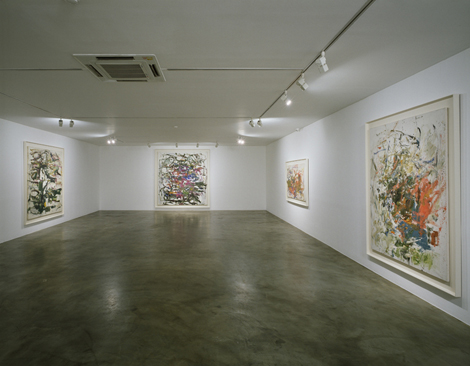
|

|
|
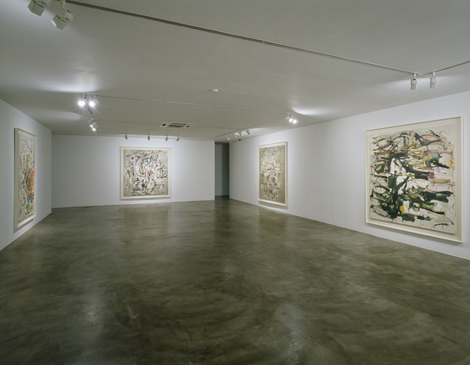
|
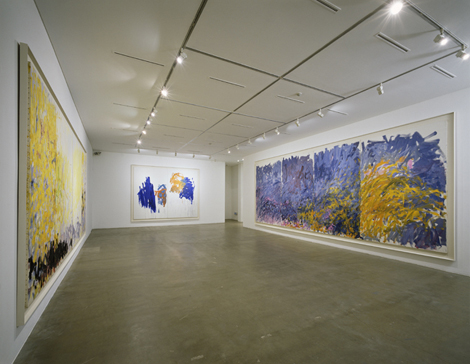
|
|
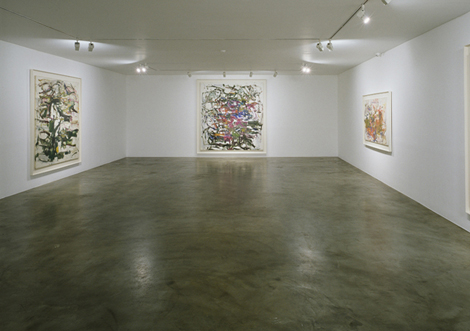
|
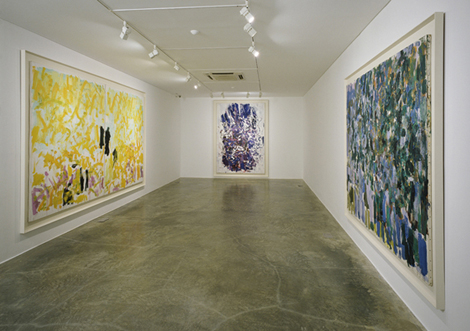
|
|